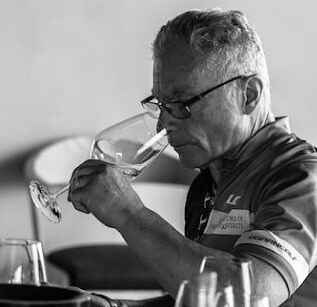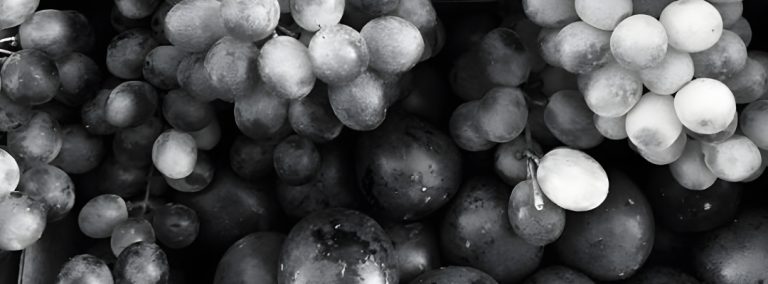We rely on our senses when we drink wine, primarily taste and smell, but we can also use our eyes to appreciate the color and clarity of the wines we’re drinking. Focusing on the aesthetic value of wine helps us more fully experience it, but color can also tell us some important things, from how old the wine is, to which grape varietals were used, and how it was made, including if the wine has had oak aging. To properly see the color in your glass, pour a little wine and lift it up against a white background. Next, look at it from an angle, observing the different shades.
Wines come in many colors, they’re not just red, white and pink. A glass of Malbec can have deep purple tones to it, whereas with a red like Chianti, you’ll likely see more of a ruby color. A wine made from the Nebbiolo grape can be brickish red, and some rosé, like Cerasuolo d’Abruzzo from Italy, can be so dark pink you might even call it cherry. The colors of white wine can range from shades of pale straw, as seen in a Muscadet, to straw with hints of green, in a Riesling or Sauvignon Blanc, and golden shades in a Chardonnay or Chenin Blanc.
A wine’s color is influenced by a number of factors, including the climate where the grapes were grown, the vintage of the wine, exposure to oxygen, its age, and if it’s filtered or unfiltered. You can also have different densities of color in wine. For example a young Cabernet is opaque, whereas a young Pinot Noir can be so translucent you might even see your fingers through the glass.
Wine Fact: Did you know that appreciating a wine’s color is one of the reasons why it’s best not to overfill wine glasses? You need to be able to tilt them, swirl them and really see what you’re drinking.
Where does a wine’s color come from?
Red and rosé wines get their color from the grape skins that are used to make them. For white wines, you are looking at the natural color of the pressed grape juice, plus the effects of aging in oak barrels or stainless steel, which can alter color. For example, an unoaked Chardonnay will likely be a medium golden color with greenish shades, whereas a Chardonnay that has seen oak aging can be a deeper gold, which it gets from the wood barrels and exposure to air. Orange wines are white wines that spend some time on their skins, giving them their unique range of colors.
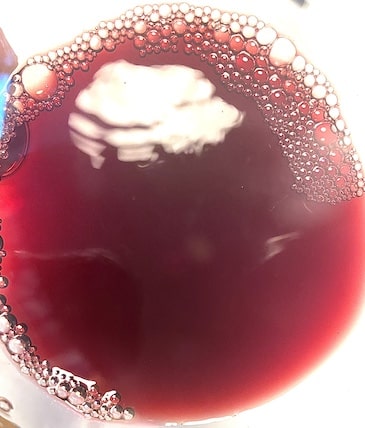
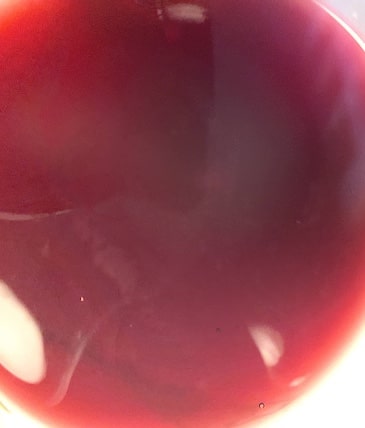
More on maceration
The juice of red grapes is just as colorless as that of white grapes, but when red wine is fermented, red, purple, and blue pigments are extracted from the grape skins, along with tannins. This initial fermentation process is known as maceration and the color pigments are called anthocyanins – they exist in other fruit and vegetables too. How long the juice is soaked with the crushed grape mix affects the depth of color and the resulting shades, the flavors, and the tannins you’ll have in the wine.
Maceration is thus an important step in a red wine’s production that helps determine the structure of the final wine. If a winemaker is producing a big Cabernet Sauvignon that’s meant to be aged for a long time before drinking, the wine might undergo a longer maceration process so it will have a higher tannin content. As a result, more color and flavor will be extracted and you’ll likely see deeper shades and more density of color in the wine. Density is just how much light can shine through the wine. Note, it takes longer for a red wine with a higher tannin content to mature and develop.
Wine fact: Whites don’t undergo maceration, but reds do.
Same wine, different vintage, different color
A wine’s vintage describes the year the wine was produced. One vintage can differ from another, and this can impact the exact shades of color in the wine. Why? Well, every year vineyards experience different weather and this affects the fruit in particular ways. You might have a year that produces thicker skinned grapes, which means you’ll likely see more color and a higher tannin content in the wine. You may also have a year that results in smaller grapes, so there is proportionally more grape skin to juice. This can also increase the intensity of color and the tannins that come out of the maceration process.
Some wines have more variance between vintages than others. A good example is with a red wine like Pinot Noir. Pinot Noir vintages can be light, or they can be much deeper. This is because the Pinot Noir grape already produces a light red wine, which opens the door for more variation. You also have this effect with wines made from the Nebbiolo grape.
The opposite is true of a Cabernet Sauvignon, where the wine is always going to be deeper in color and fairly opaque. Syrah is another red wine where you’ll see less of a color difference between vintages.
Wine fact: Lower acidity wines are usually grown in warmer climates and tend to have almost a blue-purple tinge to them.
How does aging affect color?
Wines change color as they age. For example, a red wine might go from a bright ruby red to more of a brown shade of red. It depends on the grape variety and how the wine is stored, but you can start to see this effect in wines that are three to five years old. When you pour or decant the wine, you’ll note the rim will be more of a brickish red compared to the wine in the center of the glass. A white wine may go from a pale green or light yellow shade, to a darker color as it ages. For example, some Rieslings can go from a brilliant silver or green tone to a gold-copper hue after a period of years. So the inverse is true, reds lose some of their color and white wines tend to gain color as they age.
Is the wine filtered or unfiltered?
Filtering is a process that removes some of the by-products of fermentation from wine. A wine that is unfiltered may not be as clear or bright. When it ages, it will also have more sediment.
The colors of white wine
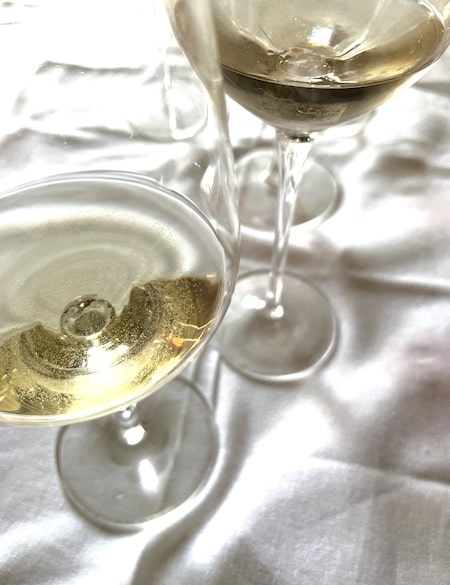
There’s a spectrum of colors you can expect with white wines. A white can range from pale straw to medium to deep gold. Keep in mind not every Sauvignon Blanc or Chardonnay will look the same or have the same taste, that’s part of the beauty of trying different bottles and fully experiencing their aesthetic value and aromatics!
Here are some different types of white wine and their typical colors:
- Chardonnay. A Chardonnay can be a light to medium gold or you may find a deeper golden color. Chardonnay is a wine that’s often aged in oak, and the aging process can affect how it looks. Learn more in this article.
- Sauvignon Blanc. A Sauvignon Blanc is a higher acidity wine that’s usually pale to medium yellow and can have a greenish tint. A Bordeaux Blanc which is a white wine that’s a combination of Sémillon and Sauvignon Blanc, can have more shades of gold.
- Pinot Grigio / Pinot Gris. Pinot Grigio and Pinot Gris are the same wine, they just have different names. The colors you’ll find in this white can range from medium straw with green notes to a pale gold.
- Riesling / Grüner Vetliner. You can expect to find pale yellow colors with greenish tones in a Riesling or Grüner Vetliner which are wines with good acidity. Note, if a silver-green tone Riesling is aged it can become more golden and copper.
- Muscadet / Albariño. Muscadet and Albariño are lighter and will be more pale to medium straw.
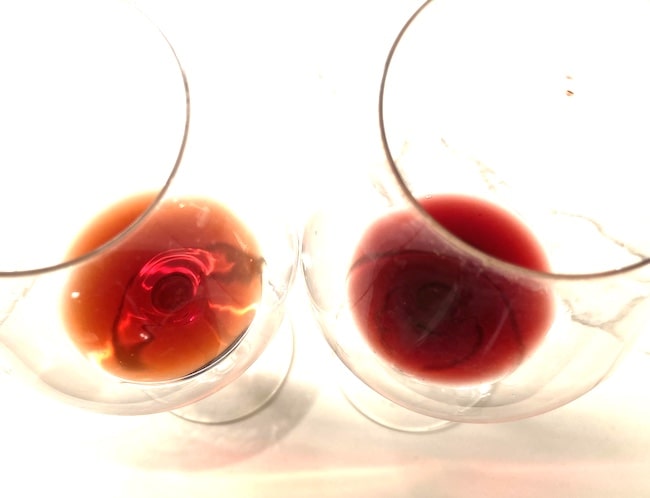
The colors of red wine
You can see a range of colors in red wine. You might find ruby, garnet, or even deep purple shades.
Here are some common reds and their colors:
- Malbec / Syrah or Shiraz. These tend to be the darkest colors you’ll find and can range from a medium to deep purple with notes of blue.
- Cabernet Sauvignon and Merlot. You’ll see deep ruby colors in a Cabernet Sauvignon or Merlot, both of which can be quite opaque.
- Pinot Noir. These wines have higher acidity and tend to be pale to medium ruby-red and less opaque. However, a Russian River or Central Coast Pinot can be quite dark and concentrated. So remember, there’s always a range.
- Sangiovese-based wines. Chianti, Chianti Classico and Chianti Riserva all tend to be on the garnet brick-red spectrum and can be medium to dark.
- Barolo / Barbaresco. Nebbiolo grapes produce wine that’s pale to medium garnet. Garnet is a red that is not as bright as ruby and sometimes has hints of brown in it. Barolos tend to be darker than Barbarescos and both of these wines have good acidity.
More on rosé
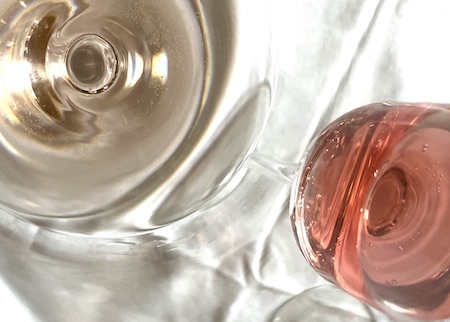
Rosé is made in two ways. Some rosés are aged for a short period with crushed red grapes and this is how they get their color. Rosé can also be made more like white wine. Nonetheless, some of the juice undergoes maceration. It is then added back into the final blend which gives the wine its pink color. You can achieve different pinks based on what percentage is added back into the wine. This is one reason why it’s impossible to make any sweeping statements about the color of rosé, which can range from pale pink and salmon, to deep pink and salmon, to even a light ruby. It depends on the style of the winery producing it.
Orange wines
This wine is a white wine where the grapes have been fermented on their skins. Unlike a rosé that spends very little time with the crushed grapes and picks up fewer pigments, an orange wine might spend longer which means more color and flavor are extracted during the maceration process (though not as much as with red wine!). This is actually how white wines were originally made and is a more traditional approach that was prevalent before modern winemaking techniques and science took over.
The length of time the wine undergoes maceration determines both the intensity of the color as well as the change in flavor profile. Tannins are also extracted which affects the mouthfeel of the wine and it can be more complex as a result. Because of the added mouthfeel and flavor, these wines go well with more heavily spiced food. You might also serve them with smoked dishes or if you’re not cooking, a good wine food pairing would be a selection of strong and intensely flavored cheeses.
The Italian wine Pinot Grigio was originally made this way. When you see a Pinot Grigio labeled “Ramato” it means it has spent time on its skins and will have that same orange tinge and added flavor and texture.
What else might you see in your wine?
Sediment
As the tannins in a bottle of red wine evolve, there’s a by-product, which is sediment. Sediment tends to look like a small pile of light brown particles that settle at the bottom.
Tartrates
A white that isn’t heavily filtered can sometimes have tartrate crystals which look like small shards of colorless glass in the bottle or on the cork. They are actually tartaric acid that has crystallized. You mainly will see this in white wines that have not been filtered or only lightly filtered and they usually appear as the wine is chilled. Note, they are harmless if consumed.
Bits of cork
Sometimes a cork may break off when you’re opening a bottle of wine. It can leave a small powder that floats at the top. When this happens it may be because the cork has dried out. Learn more about the importance of humidity when you’re storing wine in this article.
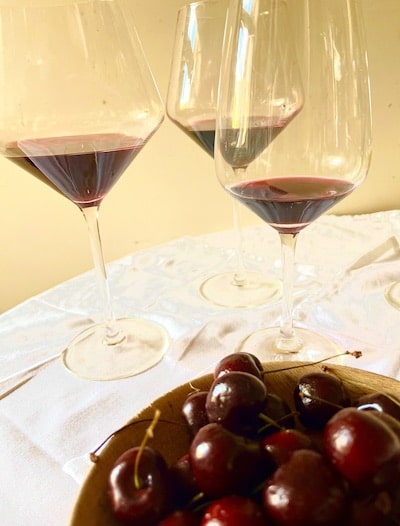
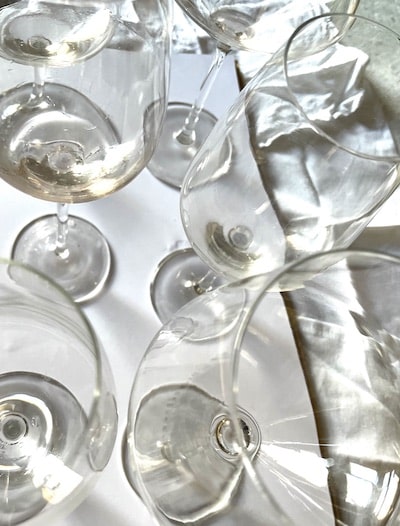
How to take notes on the color of the wines you’re drinking
You might want to write down some notes to help you draw comparisons between the colors of the different wines you’ve tried. You can take notes on the brightness and hue of the wine and have a look at the wine’s legs. This is when you swirl the wine and can see its viscosity, which can be affected by the alcohol content, the sugar content or both.
There’s no right or wrong answer when it comes to descriptions of wine color. You can draw comparisons to an item from the natural world, such as a fruit or plant, a particular food you enjoy, clothing colors – think, a burgundy sweater, or even shades of lipstick! Just do what feels right and remember to have fun at the same time.
- Start by looking at the density of the colors and their intensity. Can you see your fingers through the glass?
- How clear is the wine? Is it a bright or dull shade of a particular color? Does it have sediment floating in it, or if it’s a white, crystals? Is it cloudy?
- Where does the color fall on the color spectrum? Is it deep violet with blue edges or more of a rich ruby? If you’re struggling to describe it, how does it compare to the colors in your food?
- How do the colors at the edge of the wine differ from the colors at the center? Does it have an orange, red, brown or blue edge?
As we’ve discussed, different glasses of wine have different colors and both the exact shade and concentration can tell you some important things, from which grapes the wine was made with, to how old it is.
You may think you know what to expect when you pour wines like Merlot or Cabernet, but you can also be surprised by what you’ll find. So, the next time you open a bottle of red, white or rosé, before you taste it, turn up the lights and have a closer look!

